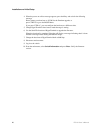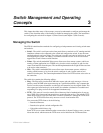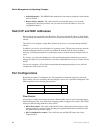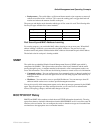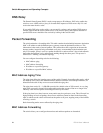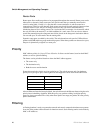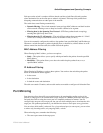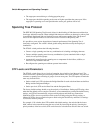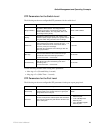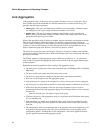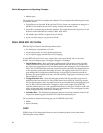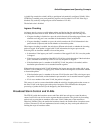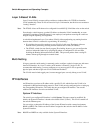28 ZT8101 User’s Manual
Switch Management and Operating Concepts
• The target port cannot belong to a link aggregation group.
• The target port should be operating at the same or higher speed than the source port. If the
target port is operating at a lower speed than the source port, packets will be lost.
Spanning Tree Protocol
The IEEE 802.1D Spanning Tree Protocol allows for the blocking of links between switches that
form loops within the network. When multiple links between switches are detected, a primary link
is established. Duplicated links are blocked from use and become standby links. The protocol
allows for the duplicate links to be used in the event of a failure of the primary link.
It is possible to cause serious degradation of network performance if the Spanning Tree is
incorrectly configured. The switch’s default global setting should be used by the majority of
installations.
The ZT8101 switch performs the following functions:
• Creates a single spanning tree from any combination of switching or bridging elements.
• Creates multiple spanning trees from any combination of ports contained within a single
switch, in user-specified groups.
• Automatically reconfigures the spanning tree to compensate for the failure, addition, or
removal of any element in the tree.
• Reconfigures the spanning tree without operator intervention.
STP Levels and Parameters
The ZT8101 switch allows for two levels of operation: the switch level and the port level. The
switch level forms a spanning tree consisting of links between one or more switches. The port level
constructs a spanning tree consisting of groups of one or more ports. The STP operates in much the
same way for both levels.
• On the switch level, STP calculates the Bridge Identifier for each switch and then sets the Root
Bridge and the Designated Bridges.
• On the port level, STP sets the Root Port and the Designated Ports.
The factory default settings should cover the majority of installations. Setting up STP using values
other than the defaults can be complex. Therefore, we recommend that you keep the default factory
settings, and STP will automatically assign root bridges/ports and block loop connections.
Influencing STP to choose a particular switch as the root bridge using the Priority setting, or
influencing STP to choose a particular port to block using the Port Priority and Port Cost settings
is, however, relatively simple.
For example, if all switches have STP enabled with default settings, the switch with the lowest
MAC address in the network becomes the root switch. By increasing the priority (lowering the
priority number) of the best switch, STP can be forced to select the best switch as the root switch.



